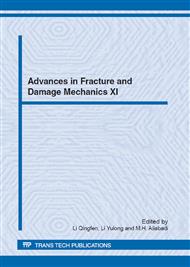p.325
p.329
p.333
p.337
p.341
p.345
p.349
p.353
p.357
Yield Criterion and Crack Tip Plastic Zone of Nickel-Based Single Crystal
Abstract:
A modified Hill yield criterion considering tension-shear stress coupling was given and material parameters of nickel-based single crystal in this criterion was determined by the Least Square Method. Crack tip plastic zones of nickel-based single crystal plate were analyzed by using this modified yield criterion and the plastic zones corresponding to mixed mode I, II crack, were derived. The crack tip plastic zones of nickel-based single crystal were compared to that of isotropic material. The influences of tension-shear stress coupling, compound ratio of mixed mode I, II crack and temperature on crack tip plastic zones were discussed. The results obtained in this paper indicate that the increasing rate of crack tip plastic zones with compound ratio in the plane stress condition is greater than that in the plane strain condition for nickel-based single crystal and the temperature has greater influence on the size of crack tip plastic zones.
Info:
Periodical:
Pages:
341-344
Citation:
Online since:
November 2012
Authors:
Price:
Сopyright:
© 2013 Trans Tech Publications Ltd. All Rights Reserved
Share:
Citation:


